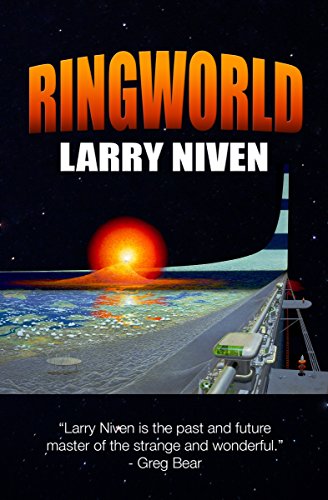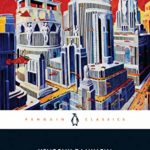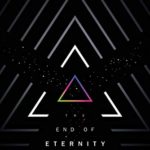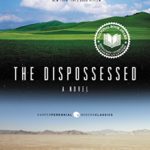If you’re new, as I am, to Larry Niven’s Known Space world, you’ll find an astonishing amount of information online about this hugely influential series of novels and short stories. Ringworld (1970) was Niven’s first novel in the sequence. There are articles about all the characters, alien species, technologies and events of Known Space as well as its timeline. And there are spinoff stories and games galore. But, compared to other works of its time, Ringworld as a novel is not the sort of science fiction that I like to read.
The basic story about exploring a megastructure, a giant ringworld surrounding a star, is compelling, and the characters have to come up with one intriguing idea after another to get themselves out of near-fatal encounters. The alien species Niven created are among the most interesting I’ve seen, and the adventure is well told and fairly satisfying. That adds up to a considerable achievement but doesn’t make up for the absence of character development and the abominable presentation of the story’s two female characters.
The story begins on Louis Wu’s 200th birthday party in 2850 CE, an event made possible by his consumption of boosterspice that keeps him relatively youthful. Although he first appears in a sort of Fu Manchu costume with long white hair in a queue down his back and chrome yellow skin (I almost stopped right there), it soon becomes clear that his real appearance is a blend of all races. He meets Nessus, a Pierson’s Puppeteer, that is, a three-legged alien with two snake-like heads on stalks who speaks a language that sounds like orchestral music, though he also speaks the Interworld language that all the other characters use. Puppeteers are herbivorous and timid by nature, and Nessus often wraps himself up into a ball when danger is present.
Nessus is organizing a small crew to fly to his home world and from there to take a faster-than-light spaceship to explore a mysterious star system. This ship is powered by engines that are not merely FTL but can cover a light year in 1.25 minutes. If Wu accepts the offer, without knowing anything else about the destination, he will be able to keep the starship, which has profound implications for humanity. Louis Wu accepts but reluctantly, especially when he finds out who the other two crew members will be.
One is a kzin, an aggressive, carnivorous alien species that has fought a long series of wars with humans. Speaker-to-Animals, as this kzin is called, is a cat-like creature who stands on two legs, is eight feet tall, and has fangs, claws and a roar so fearsome as to make him a walking terror. And kzin have a heroic code of conduct which often leads Speaker to challenge anyone to fight for even minor insults.
Teela Brown is a beautiful twenty year-old who becomes Louis Wu’s lover and is so attached to him that she wants to join the expedition. But it turns out (spoiler here) that the Puppeteers have been interfering with human evolution by breeding people with the trait of being exceptionally lucky. That is the reason Nessus wants her to join, even though she has no other qualification. She also has pretty good problem-solving instincts that prove helpful, and Louis is constantly reminding himself that he underestimates her intelligence. However, when her luck turns and the expedition runs into trouble, she also experiences pain for the first time and so has an opportunity to grow. The trouble with that character arc is that we only hear about it through Louis and have no sense of her inner growth from her perspective.
When the group arrives in their FTL ship, called the Lying Bastard, reaches the destination, the crew finds the vast Ringworld, circling its star. It has a width of a million miles and is hundreds of millions of miles in circumference. By rotation, it creates an artificial gravity close to that of Earth, and a day-night cycle is made possible by gigantic shadow blocks that are tethered by an almost invisible and razor sharp wire. The ring is made of an almost indestructible material, and an artificial landscape has been created on its inner face where vast numbers of people can be supported. Cities dot the landscape, and there are mountains and oceans, including one vast volcano-like structure called the Fist of God that is a thousand miles high.
As soon as they bring the Lying Bastard in close for a landing, however, they snare the sharp and indestructible shadow wire. It rips off the outer engines and wing forcing them to make a crash landing. Fortunately, the FTL drive and life support systems are intact within the hull, which is made of an impermeable material produced by the Puppeteers. The crew will not be able to leave Ringworld unless they can somehow lift their ship into near space where they can ignite the FTL drive. So they set off in their flycycles (comparable to a flying motor cycle that can surpass the speed of sound) in search of civilization and help.
What they find, though, is that civilization has collapsed, and the scattered populations survive in ruined cities, pinning their hopes on the return of the gods who created their world. The rest of the story is about the crew’s adventures encountering floating buildings, hostile people who attack them, and violent storms. They are trapped, at one point, inside an abandoned police station where they meet a woman named Halrloprillalar or Prill. She turns out to be the survivor of another wrecked spaceship on which she served as one of whores to meet the needs of the male crew. (Why am I not surprised?) Using her skills, she seduces Louis by playing him like an instrument, but with the aid of one of Nessus’ tools called a tasp (that instantly stimulates the pleasure center of the brain), she becomes addicted to Louis (ie. falls in love) and stays with the crew to help them escape.
Meanwhile, Teela has found herself a strapping hero called Seeker (as Niven puts it, right out of central casting) with a long sword (a real one), falls in love and decides to stay on Ringworld with him rather than escape with the others. There is a potentially interesting character arc for Teela. She is the lucky woman who has never been hurt and who discovers various setbacks while on Ringworld. Ah, a chance to realize what life is like for everyone else and mature into a rounded person? – but it doesn’t quite turn out like that. We don’t learn anything about her from Teela’s own perspective. It’s up to Louis to explain her character, or initial lack of it, and how she is maturing by experiencing pain or bad luck. Whatever she learns, she trades one male lover for another and commits herself to following her hero’s lead, despite her own intelligence and problem-solving ability.
One star of the show is Ringworld itself, an amazing construction long since abandoned by its engineers. Its habitable surface has a breathable atmosphere and a surface equal to a million earths. Another star is the hopeful and brimming technological imagination of the characters, who often work together to come up with solutions to every problem. Really, this imagination and problem-solving ability are the key traits of each character, though each is also equipped with a distinctive personality. The thing is, they don’t change or undergo soul-searching crises or wonder much about their lives.
The great achievement of Ringworld and the industry of stories and novels that followed, many jointly written by Niven and collaborators, was to create a future history with well-drawn alien peoples, optimistic technology and high adventure that were really startling in the science fiction scene of 1970. There are reams of information online about every aspect of Niven’s fantastical inventions, the timeline of Known Space, and each species, character and world. Niven influenced just about every later writer of space opera and endures as one of the great shapers of the field.
But Ringworld, the first novel that really got this universe going, while certainly being enjoyable for its adventure, falls short for me. The characters don’t really develop much, and the women have zero agency, only attaching themselves to men. This is not a case of unfairly judging a 50+ year-old book by today’s standards. By 1970, Ursula K. Le Guin, Philip K. Dick and Frank Herbert, among others, had written much more enduring classics that used the medium to explore profound questions facing humanity. So far, I’m not encouraged to explore Known Space in all its voluminous detail.





If we look at the Teela Brown character through a pair of Niven’s 1960s magic mushroom-tinted Sci Fi 3D glasses then we must never forget that she is a puppet of her genome. According to Niven’s fantasy biology of the future, Teela literally has genes that make her lucky. Teela’s genes made her fall in love with Wu just so that he could take her to Ring World. Teela then quickly falls in love with Seeker because he is the optimal source of sperm to produce a mighty lineage leading to trillions of Teela descendants who will eventually come to populate the vast habitable surface area of Ring World. This is the ultimate goal of Teela’s astounding genes… making as many copies of themselves as is possible. Teela is just a walking container for her genes, a walking automaton, and it is a forlorn hope if we readers expect her to have any agency in the story. The XXX movie based on the novel is called “Teela Comes to Populate Ring World”.
Hi, and thanks for writing in – the question of luck is a little complicated, or maybe I’m just confused. Teela is lucky, but Nessus makes the point early on that humans generally are lucky and that’s one reason he wanted humans in his crew. Teela’s special luck doesn’t always transfer to the rest of the crew or the mission since they crash land and have so many problems. But, yes, she herself stays lucky. Now, I’m not sure I would equate luck genes with the genetic urge to procreate, since the latter is so basic in every race. Selecting the strongest male for procreation is to be expected, and let’s say it’s luck that she runs into Seeker. But I don’t see that either luck or the urge to reproduce would have to make her an automaton – she could still be a much more interesting and well-rounded character. Did Niven believe that genetic inheritance eliminates free will – or that one trait overrides all others? Interesting questions!